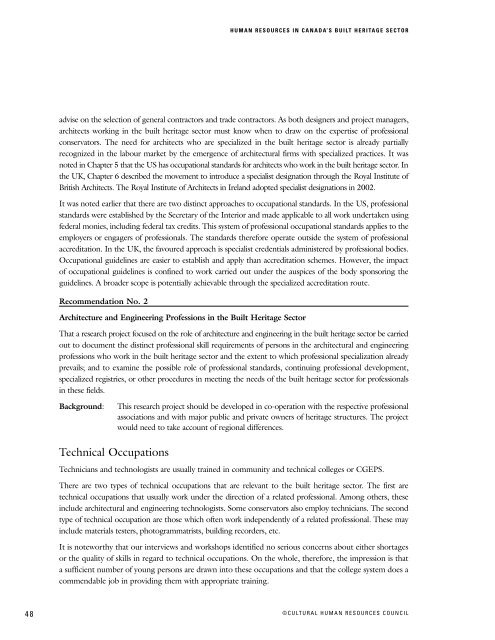Human Resources in Canada's Built Heritage Sector: Mapping the ...
Human Resources in Canada's Built Heritage Sector: Mapping the ...
Human Resources in Canada's Built Heritage Sector: Mapping the ...
- No tags were found...
Create successful ePaper yourself
Turn your PDF publications into a flip-book with our unique Google optimized e-Paper software.
HUMAN RESOURCES IN CANADA’S BUILT HERITAGE SECTORadvise on <strong>the</strong> selection of general contractors and trade contractors. As both designers and project managers,architects work<strong>in</strong>g <strong>in</strong> <strong>the</strong> built heritage sector must know when to draw on <strong>the</strong> expertise of professionalconservators. The need for architects who are specialized <strong>in</strong> <strong>the</strong> built heritage sector is already partiallyrecognized <strong>in</strong> <strong>the</strong> labour market by <strong>the</strong> emergence of architectural firms with specialized practices. It wasnoted <strong>in</strong> Chapter 5 that <strong>the</strong> US has occupational standards for architects who work <strong>in</strong> <strong>the</strong> built heritage sector. In<strong>the</strong> UK, Chapter 6 described <strong>the</strong> movement to <strong>in</strong>troduce a specialist designation through <strong>the</strong> Royal Institute ofBritish Architects. The Royal Institute of Architects <strong>in</strong> Ireland adopted specialist designations <strong>in</strong> 2002.It was noted earlier that <strong>the</strong>re are two dist<strong>in</strong>ct approaches to occupational standards. In <strong>the</strong> US, professionalstandards were established by <strong>the</strong> Secretary of <strong>the</strong> Interior and made applicable to all work undertaken us<strong>in</strong>gfederal monies, <strong>in</strong>clud<strong>in</strong>g federal tax credits. This system of professional occupational standards applies to <strong>the</strong>employers or engagers of professionals. The standards <strong>the</strong>refore operate outside <strong>the</strong> system of professionalaccreditation. In <strong>the</strong> UK, <strong>the</strong> favoured approach is specialist credentials adm<strong>in</strong>istered by professional bodies.Occupational guidel<strong>in</strong>es are easier to establish and apply than accreditation schemes. However, <strong>the</strong> impactof occupational guidel<strong>in</strong>es is conf<strong>in</strong>ed to work carried out under <strong>the</strong> auspices of <strong>the</strong> body sponsor<strong>in</strong>g <strong>the</strong>guidel<strong>in</strong>es. A broader scope is potentially achievable through <strong>the</strong> specialized accreditation route.Recommendation No. 2Architecture and Eng<strong>in</strong>eer<strong>in</strong>g Professions <strong>in</strong> <strong>the</strong> <strong>Built</strong> <strong>Heritage</strong> <strong>Sector</strong>That a research project focused on <strong>the</strong> role of architecture and eng<strong>in</strong>eer<strong>in</strong>g <strong>in</strong> <strong>the</strong> built heritage sector be carriedout to document <strong>the</strong> dist<strong>in</strong>ct professional skill requirements of persons <strong>in</strong> <strong>the</strong> architectural and eng<strong>in</strong>eer<strong>in</strong>gprofessions who work <strong>in</strong> <strong>the</strong> built heritage sector and <strong>the</strong> extent to which professional specialization alreadyprevails; and to exam<strong>in</strong>e <strong>the</strong> possible role of professional standards, cont<strong>in</strong>u<strong>in</strong>g professional development,specialized registries, or o<strong>the</strong>r procedures <strong>in</strong> meet<strong>in</strong>g <strong>the</strong> needs of <strong>the</strong> built heritage sector for professionals<strong>in</strong> <strong>the</strong>se fields.Background:This research project should be developed <strong>in</strong> co-operation with <strong>the</strong> respective professionalassociations and with major public and private owners of heritage structures. The projectwould need to take account of regional differences.Technical OccupationsTechnicians and technologists are usually tra<strong>in</strong>ed <strong>in</strong> community and technical colleges or CGEPS.There are two types of technical occupations that are relevant to <strong>the</strong> built heritage sector. The first aretechnical occupations that usually work under <strong>the</strong> direction of a related professional. Among o<strong>the</strong>rs, <strong>the</strong>se<strong>in</strong>clude architectural and eng<strong>in</strong>eer<strong>in</strong>g technologists. Some conservators also employ technicians. The secondtype of technical occupation are those which often work <strong>in</strong>dependently of a related professional. These may<strong>in</strong>clude materials testers, photogrammatrists, build<strong>in</strong>g recorders, etc.It is noteworthy that our <strong>in</strong>terviews and workshops identified no serious concerns about ei<strong>the</strong>r shortagesor <strong>the</strong> quality of skills <strong>in</strong> regard to technical occupations. On <strong>the</strong> whole, <strong>the</strong>refore, <strong>the</strong> impression is thata sufficient number of young persons are drawn <strong>in</strong>to <strong>the</strong>se occupations and that <strong>the</strong> college system does acommendable job <strong>in</strong> provid<strong>in</strong>g <strong>the</strong>m with appropriate tra<strong>in</strong><strong>in</strong>g.48©CULTURAL HUMAN RESOURCES COUNCIL










